Text
So, I will begin by saying that I am not really on the side of the poster who is trying to score internet points in some anti-DCEU fandom war by saying "franchise bad because franchise used stock images in its marketing!" That is a pretty weak dunk.
But the response to this dunk is even weaker, because as I read it, it's not even responding to what the original tweeter was dunking on. You know when you see an argument that is so weak that it actually makes you want to defend the other side? This is one of those moments. And steelmanning is a fun intellectual exercise, so let's do some of that today: here's why dunking on Warner Bros for using Getty stock images in their marketing for a cheap laugh actually makes sense.

"Stock photos exist to be used," yes.
But I think the same can be said of stock music, right?
Like, if you spend a lot of time on certain parts of YouTube, particularly in the world where you have people who are trying to be "professional YouTubers" but who also work with small production budgets. I'm talking about the sort of "workhorse content creators" who are making a living by uploading a video every week.
What do you do, as someone who is "taking this seriously" and wants to use music properly and legally to avoid a copyright strike, but without the budget to get a custom soundtrack for your channel? You turn to Kevin MacLeod, of course.
It's not always literally Kevin MacLeod, but he's probably the man who has most "made a name for himself" by releasing all of his music under a Creative Commons Attribution license, meaning that you can use any of the music in his vast library of music just by giving him a proper credit in the video description (or, alternatively, by paying a $30 licensing fee).
And, as a result, you hear his music in a lot of videos. If you, like me, spent years in the aforementioned part of YouTube, you probably recognize some of these:
youtube
I also used to spend a lot of time playing super small indie games. When I say "super small indie games," I'm not talking about $10 Steam games; I'm talking about the sort of games that someone made for a weekend game jam and then uploaded to itch.io, or made by colleges for their undergraduate "game development" class. I've also been known to participate in game jams myself from time to time. Between that and YouTube, I've spent a lot of time listening to royalty-free music. Some tracks just live in my head, and I instantly recognize them. And sometimes I encounter these tracks out in the wild.
My local independent cinema has their own little branded "bumper" that plays at the beginning of every screening, where a bunch of stock graphics of film reels that appear on the screen to set the mood, accompanied by floating impact font delivering messages like "silence your cell phone." And every time that same bumper comes up, all I can think is, "that's one of the songs from the Garage Band sound library. I used it for a detective game I made in 2014."
I think it is totally fine and appropriate for my local independent theater to use the stock music that comes with Garage Band; they don't have the budget to hire Hans Zimmer, or license a Beatles song, or even pay some independent musician $500 to whip something up for them, and nobody cares about a 20-second bumper. As you might say, these stock tracks exist to be used.
But it would be extremely funny if I sat down in that theater, started watching the preview for a $200 million superhero movie, and then when Jason Momoa's face appeared on screen, they played music that I recognized from the Garage Band sound library.
If the official film score was incomplete when they were cutting in the trailer, and they instead ended up licensing a $30 royalty-free music track from the same site where people go when they need muzak for a radio ad, that would be funny! You won't change that by saying "royalty-free stock music exists to be used."
Now, to be clear, this is not exactly like the thing being described by the tweet that is being criticized, but it is at least analogous:
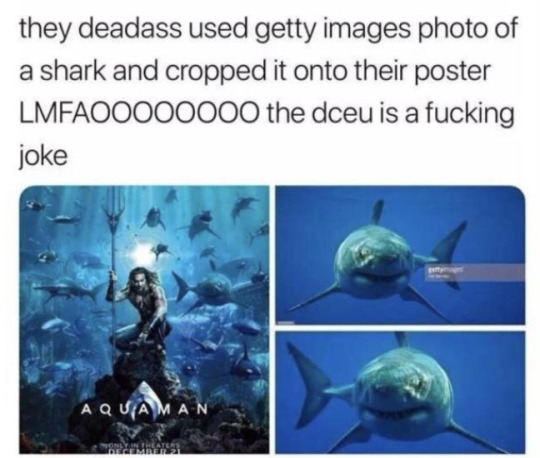
When the promotional material for Aquaman is using stock images from Getty Images, I think it is at least a little bit funny! (The Getty Images watermark in the second image just makes for the perfect visual punchline, don't you think?)
I don't know what exactly "Getty Images" means to people who don't work in media or some other industry where you sometimes need to procure visual media, but there are lots of people who did in fact sign up for SquareSpace after hearing their favorite YouTuber or podcaster do an ad read for it, and to those people, they probably associate "Getty Images" with that thing on their CMS dashboard that lets them add an image to their website for a $10 fee.
So...really, the dunk here isn't that "they used image-editing software instead of having Jason Momoa pose in front of a shark," it's that a gigantic movie studio throwing around huge wads of cash is using the same image library as us plebeians.
Think about the emotional valence of the president of the United States hosting a White House dinner and serving the guests McDonalds. The comedy lies in the contrast: "Hey, shouldn't the POTUS be hosting a White House dinner with fare that's a bit more...sophisticated than this?"
You cannot respond to that by saying, "McDonalds exists to be eaten, dummy! There is nothing funny about giving a McDonalds hamburger to a hungry person, because that's literally why their business exists!"
Well, yeah. But there are certain contexts in which you expect to encounter a McDonalds hamburger, and the White House is not one of them. (To be clear, I am not one of those people who thinks that McDonalds hamburgers are somehow "beneath the dignity" of the White House: when I say that "the image of McDonalds in the White House is funny," that is not a value judgment! I am just saying that you have to admit that it's at least a little bit funny!)
And this is what the flippant criticism seems to miss entirely:

This response does not even read as responding to the point made in the original tweet. Like, imagine if someone was talking about how it's funny that a movie trailer had a royalty-free stock music track, and then the response was, "hey idiot, the music is non-diagetic, of course an editor took an audio track and edited it in." That is a defense so weak that it isn't even addressing the criticism that is being made.
"did you think they actually photographed a dude chilling with sharks?" No. The tweet you are replying to was not complaining about the use of "photoshop" or "digital trickery," it was specifically calling out the use of stock photos from Getty Images that anyone can buy.
Here's what I think the post is gesturing at by specifically calling out Getty Images stock photos:
It's not unreasonable for someone to think that after spending $200,000,000 to make a movie about Aquaman swimming around underwater with sharks, they might have some production stills that look better than what you can buy on Getty Images for $200. You're telling me that this was the best image of a shark that they could come up with?

And look, I understand that you can very reasonably answer that question by saying "yes!"
I understand that the sorts of images that look good in the context of a movie don't always look good in the context of a movie poster. There's also the fact that all of the underwater stuff in the movie is CG, which means it probably looks worse than a photograph of an actual shark. The fact that the movie's sharks are CG also means that they're being worked on up until the eleventh hour, and these blockbuster movies have marketing cycles that take up the better part of a year, so it's even possible that the marketing team doesn't yet know exactly what the sharks in the movie will look like. And all of this is, to an extent, also fine because I understand that the purpose of promo materials like posters is to communicate a vibe more than to actually present the content of the movie. I get all of that. And yet...this defense also seems kind of tepid?
"Look, they had to use stock photography because the film's principal photography didn't get any images of actual sharks, because every single underwater scene in the movie was made in a computer, and those images look worse than photos." If that's the defense, it's kind of not doing anything to rebut the exact thing that the DCEU's critics are gesturing at when they complain about superhero films just being "CG slop."

That is, prima facie, an embarrassing admission: "we don't want to put the actual sharks from the movie on the poster because we wanted the poster to look good, and even though we spent $200,000,000 on this movie, the sharks that actually appear in our movie don't look as good as this photo we found on Getty Images." Absent any other context, that seems like the kind of thing that should get a round of mockery on twitter!
Lastly...value judgments aside, I think it's kind of funny to think that, yes, this film had a 9-figure marketing budget, and part of that $100,000,000+ budget included an invoice from Getty Images for the $200 they spent on this shark picture. The juxtaposition of that film budget with this line item is funny if for no other reason than the comedy inherent in any situation where you have an extremely large thing directly next to a very very tiny thing.


11K notes
·
View notes
Text
Power ranking of all the characters from the new Dune adaptation
I know I'm a bit late to the party on this one, but thought I'd give my thoughts on the new sequel. It's great! The first one was an amazing adaptation, and this sequel improves on everything I liked about the first one.
I will also say that while it is a "sequel," I think it works well as a standalone: I think you can skip the first one and start with the new one. In fact, I actually recommend doing this, as it's just straight-up better in many respects.
For fun, I decided to put together a "power ranking" based on how good I think all of these characters are at winning. (This isn't an aesthetic value judgment of how much I enjoy these characters; I'm only evaluating them in terms of power level, or how highly I'd pick them as a leader if all I cared about was winning.)

#1: Gurney Halleck
This dude rocks. He brings troops with him, and he'll help you get all the fun toys that let you do big explosive things.
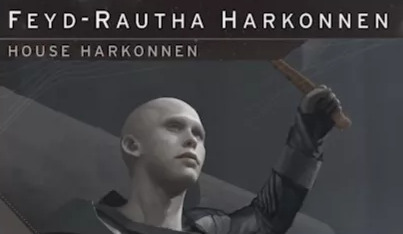
#2 Feyd-Rautha Harkonnen
If you hate Dune, the desert planet, he's your guy. No time for reconnaissance? Feyd agrees. Nobody's better at culling. Let this guy take all your daggers and thank him.

#3 Muad'Dib
Probably uncontroversial to say that having Muad'Dib on your side will help you win, assuming you favor securing an early Fremen alliance: Sandworms not only win conflicts, but also give you better rewards for winning conflicts.

#4 Princess Irulan
I like her a lot. Partly, this is the intrigue: I know that some people don't put as high a premium on intrigue, but it's always nice to have a surprise in your back pocket. Not quite as good at culling as Feyd, but she's still good at getting daggers out of your hand.

#5 Shaddam Corrino IV
If you want the Sardaukar elites, you need him. But I prefer to think of that as just a minor bonus compared to the economic benefits: Shaddam has access to cold hard cash, and if you have run out of things to spend your money on, he can use that money to buy influence with the guilds.

#6: Staban Tuek
If this were just a ranking purely based on how fun the characters are, this guy would be at the top of the list. If you have Staban on your side, you're going to have a good time.
The upsides of having Staban in your pocket are immense: if you want your pockets to be overflowing with spice, I can't think of anyone better to have at your side. The only problem (and it's a big one) is with his lack of diplomacy, as securing alliances is really important. By not having that, it feels like you're giving up several victory points that other leaders get "for free."
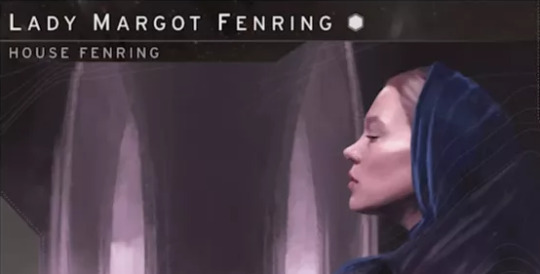
#7 Lady Margot Fenring
Nobody's better at espionage, but I kind of feel like you need espionage location cards for her to be really good. If you can draft a rebel supplier, she can provide you with a constant loop where you send spies to cities, recall the spy to recruit more troops, and constantly draw more cards. However, sometimes that strategy just doesn't come together, especially if other players at the table are hate-drafting against you.
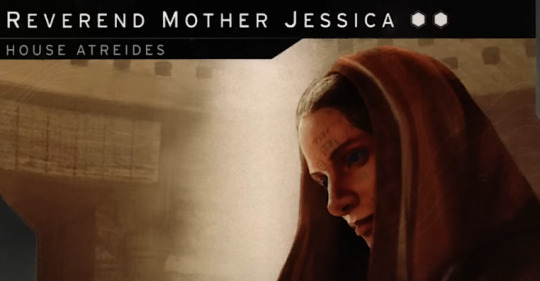
#8 Lady Jessica / Reverend Mother Jessica
Probably the best thing Jessica can do is spend an extra water to cull two bad cards, which is admittedly very powerful. I like her as a deckbuilding leader who can save up memories for a turn when there's a big important card on the market. When it happens, it feels great. The problem is that you don't have the ability to make this happen reliably. There are situations where she's amazing, but in some games she just disappoints.

#9 Lady Amber Metulli
The first time I sat down to play a game of Uprising and read her abilities, I thought she was amazing. And she is admittedly fun and easy to play. However, the more I see her in action, the more my estimation of her falls.
She seems like she has a lot going on...but she's just outclassed in every regard. She's kind of good at preserving troops by letting you pull them out of losing conflicts, but leaders like Gurney have abilities that just give you troops for free. She's kind of good at supplying you with money, but worse at it than Shaddam or Staban. She can generate spice, but is worse at it than any other leader with an ability that generates spice, and often she's generating 1-2 spice per game at a point when it's no longer relevant.
In short, she's very appealing for beginners, but as you begin to get a feel for the other leaders on the roster, it's really easy to see how she gets outclassed at basically everything she does.
Overall thoughts on the new adaptation:
As I said at the top of the post, it's a worthy sequel to a great board game adaptation, and if you're new to the series, I really do think you should just skip the original Dune Imperium and just start with Uprising.

The original Dune Imperium had a great core design, but was held back by balance issues. Uprising just feels like a much more finely-tuned game, with better card balance, better board balance, and a few small tweaks that incorporate some of the best ideas from the expansions without feeling "bloated." (Part of the benefit of releasing Uprising as a sequel rather than yet another expansion was the opportunity to just start from scratch rather than having to figure out how to tack the additions onto the original game in a post-hoc manner.)
4 notes
·
View notes
Text
Algorithmic neologisms
Much has already been said about the way that certain platforms censor or throttle certain content based on the use of certain "forbidden words," which leads users to come up with creative workarounds.
The most plainly obvious example is the way that some people say "s3x" in contexts when the word "sex" might get them flagged. And sometimes, if a platform is paranoid about use of the word "kill," then you'll start to see "k*ll" instead. But sometimes it leads to the invention of new neologisms: instead of "k*ll", you might say "unalive." And everyone knows what the eggplant emoji represents.
But one of the silliest examples of this I've seen is on YouTube.
You see, YouTube's algorithm hates hate speech. Posting hateful or hate-related content is a quick way to get your content flagged as algorithmically "unsafe."
But apparently, "hate-related content" is a category that can includes anyone using the word "hate" to describe how they feel about something. (Which, I guess is sort of true in the most literal sense, but when people talk about "hate speech," they're usually referring to something specific that doesn't include statements like "I hate Gohan.")
This has been a great source of consternation to YouTuber LordKnight, who has an entire genre of video which is predicated on the idea that "fighting game players hate every character on the roster except their own," which now have to be retitled:
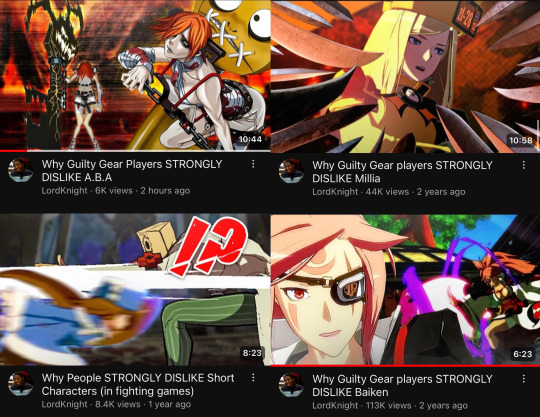
I hate short people! Their tiny hitboxes make them hard to hit in neutral!
LordKnight is not a hater! He just strongly dislikes certain characters:
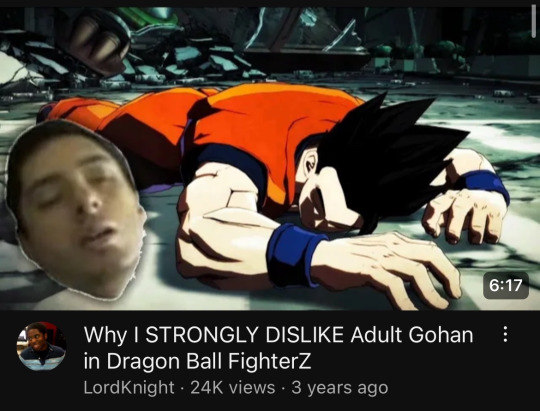
Genuine question: does "STRONGLY DISLIKE" carry less or more negative affect than "HATE?" Like, which comment would you be bothered by more if someone wrote a mean comment? Certainly, one requires more effort to type, which sort of carries the association of someone putting more effort into the bad vibes they're sending your way.
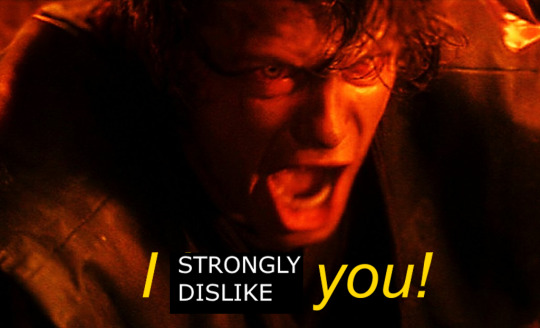
On the other hand, on a purely aesthetic level, I'm in agreement with Stephen King that the presence of an adverb is a dead giveaway that you're using a weak word: obviously, any editor reading your manuscript would see "STRONGLY DISLIKE" as a phrase that could be strengthened by changing it to "HATE."
Mentally, I just love to anthropomorphize "the YouTube algorithm" as a dinner party host who overhears someone say "I hate Adult Gohan" and yells, "HEY! Hate speech will not be tolerated in this house!"
6 notes
·
View notes
Text
It's easy for a writer to lose their own "voice"
Recently, I've been thinking about the topic of "voice" in writing, and why it's easy to recognize it when you see it, but it feels almost impossible to "teach" voice.
You can observe this in people who have years of experience writing, who then try a new form for the first time, and they write in a way that seems so utterly unlike their usual voice.
Most commonly, this happens when I have friends who have spent years writing forum posts, blog posts, newsletters, and other forms of nonfiction that have a clear distinctive style, who then attempt to "write a book" for the first time. Oftentimes, they write in a way that is is pleasantly idiosyncratic: maybe it's playfully sardonic, or refreshingly candid, or irreverent yet insightful.
But then, when it comes time to open up the document and start writing chapter 1, page 1, suddenly all of that posting experience goes away and is replaced by a new voice that can be best described as "someone doing their best impression of what they think prestigious writing is supposed to sound like."
(If you're a standup comedy buff, you'll observe a similar phenomenon at some open mic comedy night: there are certain novice comedians who haven't developed their own voice, or just don't feel confident speaking with their own voice. So, you get a lot of first-timers on stage who are clearly delivering copying the style of another comedian: they're not necessarily stealing jokes, but you can clearly tell, "Oh, this guy is doing his best Chris Rock impression," or "that's very clearly a Brian Regan-style delivery.")
In writing, this kind of "putting on airs" can take lots of forms. "Purple prose" is a commonly-named example. Another common failure mode is "thesaurus.txt" (wherein an embryonic wordsmith endeavors to traverse the labyrinthine corridors of the lexicon, brandishing polysyllabic colossi with a zeal that obfuscates rather than enriches their narrative tapestry, leaving the audience ensnared in a quagmire of lexical opulence.)
A more common and representative failure mode looks something like this:
His eyes sparkled with a luminosity that seemed to illuminate the very essence of his soul, a beacon of hope in the shadowy dusk of uncertainty.
I could pick this sentence apart and name specific issues with it. For example, there's some redundancy: "sparkled" and "luminosity" are both words that are gesturing at the same thing, so we're kind of belaboring the point about his eyes.
I might also point to the fact that there's more metaphor than actual concrete language here. In fact, we only get three words of actual physical description -- "His eyes sparkled" -- before we begin pondering "the very essence of his soul" and other abstractions. It's kind of unfair to pick this apart in isolation, because it's fine to have sentences like this occasionally, but this kind of melodramatic navel-gazing needs to exist in the context of a larger passage with enough concrete language to actually anchor it in the story, and some writers seem over-eager to leap right into excessive introspection.
There's also the fact that the sentence ends with an appositive phrase that is 10 words long: "...a beacon of hope in the shadowy dusk of uncertainty." This is weird in two ways: first, the appositive is long, and secondly, appositives usually go in the middle of sentences, rather than at the end. (For an example of a short appositive used mid-sentence: "My brother, an avid cyclist, participates in races every weekend.")
Also, it's grammatically unclear what the appositive phrase at the end is even referring to:
His eyes sparkled with a luminosity that seemed to illuminate the very essence of his soul, a beacon of hope in the shadowy dusk of uncertainty.
What specific noun is being described as "a beacon of hope in the shadowy dusk of uncertainty?" Is this phrase referring to his soul? His eyes? The luminosity in his eyes? Even though I get the general gist of what this flowery language is gesturing at, it's not precisely clear what this sentence actually means.
I could probably go on, picking apart that sentence to describe all of the ways in which it's "flawed," but I don't think this finely-tuned dissection is really necessary, because I think people instinctively understand what's wrong with it, even if they couldn't fully articulate it. In my eyes, all of these issues boil down to the same thing: it comes across like a sentence written by someone who is trying too hard.
That issue of "trying too hard" extends to a large swath of critique leveled at this sort of amateur writing mistakes, including purple prose, forced poeticism, and text that is overloaded with metaphors.
I want to be clear about one thing: Avoiding these problems isn't a matter of creating a list of "things not to do." In fact, I've developed a bit of an aversion to any piece of writing advice that begins with the word "DON'T" or "AVOID." Writing well isn't just a matter of "avoiding flaws." This isn't a school assignment where you're trying to minimize the amount of red ink the teacher leaves on your paper.
As an aside: that mindset is a bit at odds with a lot of the ecosystem of "online writing advice," because some of the most widely-circulated writing advice tends to be things like "top 10 mistakes new writers make." You can observe this on YouTube: even on channels that cover a mixture of "negatively framed advice" and "positively-framed advice," sort their videos by "most popular," and you'll find that the negative framing tends to be the more popular format by far:

To be clear, Jed Herne (pictured above) does plenty of stuff that is framed positively! He has plenty of videos that aren't themed around "things you should avoid doing." However, when you sort his videos by "most popular," you notice that the thing viewers seem to have the biggest appetite for is the video that promises to show them all of the potential failure modes that they can stumble into as a new writer.
I understand how this type of "writing advice" can be addictive. Part of why these sorts of videos are so popular is that they encourage a consumptive mindset that leads to higher "engagement" and "watchtime" and all of the metrics that the YouTube algorithm is designed to reward: YouTube wants you to stay on YouTube so you can keep watching ads; YouTube does not want you to close the app and start writing. And in looking at the most popular videos from "writing advice" channels on YouTube, we see an emergent phenomenon that reveals which videos are best at keeping viewers stuck in a consumptive watch loop: "6 worldbuilding mistakes every new writer makes." "First chapter mistakes new writers make."
This format is great at making you feel justified in your consumptive behavior: "Well, I can't just start writing -- I need to learn all about all the classic 'new writer mistakes' first!" But I think this is ultimately counterproductive for new writers. Not just because it encourages "content consumption" over the act of writing, though that is of course a problem. But, perhaps worse than that: even when writers do finally decide to write, they do so with a sense of dread and anxiety. They're aware of all of the various ways that their writing could fail, and they're deathly afraid of falling into one of those "new writer traps" that the top 10 list helpfully informed them of. So, rather than just sit down and write, they agonize over the opening sentence. They can't "just write," because they don't want to stumble and embarrass themselves. And I think that this place of insecurity is actually what causes people to write in a way that feels like it is "trying too hard."
If you want to write fancy prose and use ornate metaphors because that's what you're comfortable with, go for it! But all too often, I think that these are downstream of new writers' insecurity with their natural writing voice. They sit down, think of a sentence, and think, "Oh, I can't write that. It's too plain. Too boring. Too normal." And that's when they reach for the thesaurus, or whip out the mixed metaphor, or add a 10-word appositive to the end of the sentence, because somehow they feel that their natural voice isn't "good enough" for the book they are writing.
The irony is that a lot of people stray away from their own natural voice because they're afraid that something that sounds like their everyday speech will sound "too generic." And so, in the quest to avoid "sounding generic," they abandon their own unique voice, and instead write their best impression of what they think a prestigious-sounding writer is supposed to sound like. They start trying too hard, and that is how they end up with cliche-sounding sentences like "His eyes sparkled with a luminosity that seemed to illuminate the very essence of his soul, a beacon of hope in the shadowy dusk of uncertainty."
Assessing the uniqueness of your own voice is one place where you cannot trust your own judgment: your natural voice might sound "generic" or "normal" to you, because you live with it every day. But your voice is unique in ways that are completely invisible to you, that will nonetheless shine through if you just get out of your own way.
More than anything, I'd really like to disabuse young writers of this fear of writing something that sounds too "normal," as if the sort of writing that feels natural to you is going to appear "generic" or otherwise "not good enough."
To be clear, it's fine to experiment! Certain voices work better for different characters and styles of narration. Maybe you have written enough to realize that your most 'natural voice' doesn't work for the story you're telling, and you need to make several attempts at exploring different styles before you find one that really "clicks" with you. Every time I try writing a different viewpoint, or write a plot that is paced differently, my voice often shifts, and there's a bit of time as I work out the best way to write a story that is faster-paced and less contemplative, or a story from the perspective of a younger and more naive character. I am always trying new things to see if maybe there's a better way than my current "default."
But, before you begin, maybe it's worthwhile to ask yourself: is the voice that you've spent your entire life thinking and speaking in suitable for the story you're writing? Before you begin writing that sci-fi novel by doing your best impression of some other sci-fi writer, or writing the way that you think fantasy narration is "supposed" to sound, consider that perhaps your existing voice is already "good enough." You won't know until you try.
14 notes
·
View notes
Note
found my way here because i'm currently playing idol manager and wanted to see more from its writers. many thanks for your work on it and for this blog. i really adore your writing voice so reading all your posts will be a treat lol
Thank you for the kind words!
I especially appreciate hearing comments about my voice, as it's one of the things that I have the least perspective on. (When I'm evaluating a plot or character arc I've written in a story, I can sort of evaluate it in reference to other plots or characters I've written in the past, but my voice tends to be pretty consistent, so I lack perspective on my own voice for the same reason that fish lack perspective on the nature of water.)
Apart from people giving me direct feedback, the only time I really get to see my writing "from the outside" is when I read something from years ago that I don't recall writing. (This is part of why I enjoy blogging -- it's fun to find a "snapshot of the past" that lets me see what sort of person I was in a specific moment in time, and any time I post, I'm creating one of those artifacts for my future self to discover.)
3 notes
·
View notes
Text
How often do men think about Japan's warring states period?
Imagine a woman who is obsessed with Miyamoto Musashi, the 16th century Japanese swordsman and philosopher. Okay, she might deny that she's obsessed with Musashi, but here are the things that an objective observer might note:
When people ask her what her favorite book is, she says it's the The Book of Five Rings, the book which contains Musashi's teachings, or the Niten Ki, the earliest biography of Musashi.
At least once a week, she makes a post on her Instagram that is a quote from the The Book of Five Rings or Dokkodo, like "Do not let yourself be guided by the feeling of lust or love" or "Do not fear death"
She has a group of friends that she specifically met through her love of Musashi. Once a week, she grabs her copy of The Book of Five Rings, and goes to meet up with her friends to discuss a specific passage from the book and how to apply its message to their lives.
(She used to have a previous friend group that was really into Musashi in the city where she went to college; when she moved, one of the first things she did was find a new group of people who like Musashi as much as she does.)
If you asked her what she's looking for in a husband, one of her qualifying criteria would be, "He has to love Musashi and live in accordance with Musashi's teachings."
One day, she's scrolling through TikTok and sees a video from a woman saying, "Ladies, did you know that all men are obsessed with Sengoku-era Japan? If you don't believe me, go and ask your man how often he thinks about the Japanese warring states period."
Our Musashi-loving heroine laughs and says, "Oh, my boyfriend would never." But, amused by the idea, she asks him, "Hey babe, how often do you think about the Sengoku period?" He pauses and says, "Hmm, maybe once a day. Isn't it common for most men to think about serving under a daimyo who orders them to pick up a katana and march into battle?" She laughs and says, "You're doing this as a bit, aren't you?" He says, "No, I was obsessed with the Sengoku period as a kid, and I still am." He pulls up his Steam profile and shows her that he has spent 500 hours playing "Total War: Shogun 2," then shows her his PlayStation profile, where he's completed all of the achievements for Sengoku Basara 3, Sengoku Basara 4, Sengoku Basara: Samurai Heroes, and Sekiro: Shadows Die Twice. He then shows her his DVD collection, which contains movies like Seven Samurai and Heaven and Earth. He says, "when I was a kid, I had a LEGO set with samurai characters, and I would play with them and imagine what it would be like to live in Japan during the warring states period. I still think about that, from time to time. Sometimes, I'll see a knife with a particular shape that looks sort of like a katana, and it makes me think about the Sengoku period."
She laughs. "Okay, okay, you've convinced me. I didn't realize that men spent so much time thinking about the Sengoku period."
He then asks her how often she thinks about Sengoku-era Japan. "I don't know," she says. "Like...never? Not since high school history class."
During this conversation, it doesn't occur to either of them to comment on the fact that she is a huge fan of Musashi, one of the most famous historical figures who lived during the Sengoku period.
That would be weird, right?
Okay, now replace "Musashi" with "Jesus," and "Sengoku-era Japan" with "the Roman Empire."
16 notes
·
View notes
Text
This is not a Mission Impossible 7 review
I just watched Mission: Impossible - Dead Reckoning Part One, and I appreciate the fact that it actually included “Part One” in the title, unlike a certain other movie currently playing in theaters that ends on a cliffhanger. In fact, Mission Impossible 7 actually does a better job of having a “conclusion.” (The conflict isn’t resolved, but at least it doesn’t end in the middle of a scene!)
As best I can tell, these movies are impossible to spoil for the reason that nobody really knows the plot of the Mission Impossible series, or alternatively, everyone knows the plot of the Mission Impossible series, because they’re all the same. The details don’t really matter; the plot is an excuse for us to globe-trot between different exotic locales that serve as interesting set pieces for cool action scenes. The world is in peril and Ethan Hawk has to retrieve a macguffin to save it.
The movie has some great action sequences. The airport sequence early on in the movie is some of the most fun I’ve had watching an Mission Impossible movie.
The Rome street chase is also fun, and perhaps the most explicitly comedic part of the movie, which thrives on the classic trope of placing highly-competent characters into situations where they can’t fully flex their competence. (It’s amazing what the addition of a set of handcuffs can do to a scene.) The Rome driving sequence is also memorable in no small part because Pom Klementieff gets to do a lot of acting, despite having almost no dialog: she is great at playing the heavy.
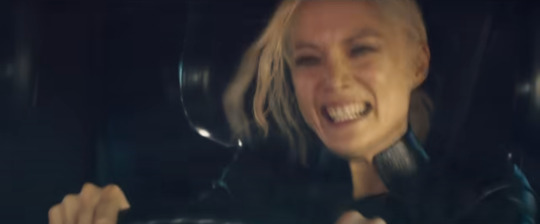
This action sequence is a perfect example of what I mean when I talk about “scenes that let actors act using their faces.” It is a great performance (and I look forward to seeing more of her performances in the future now that Guardians of the Galaxy has put her on everyone’s radar).
Also, in addition to being a globe-trotting adventure about jumping from one locale to another, Mission Impossible movies also include costume changes that are just as drastic, and her character benefits tremendously from this:

(Seriously, her character is just so cool.)
While the airport sequence is one of the best sequences I’ve seen in a Mission Impossible movie, the Venice sequence is, well, significantly more fraught. In fact, I might rank it lower than any other sequence I can remember from a modern Mission Impossible movie (which I’m going to arbitrarily define as Mission Impossible 4 onward, since that’s when the series hit the point where “basically everyone agrees that all of these movies are pretty great.”)
The Venice sequence, at its weakest points, is weirdly bad. (Which, to be clear, I actually prefer -- things that are weirdly bad will always be preferable to things that are just boringly bad.) There are lots of action movies with bad action that is just creatively bankrupt. But the Venice sequence actually has some great ideas, many of which it actually executes competently -- and then there are some places where the execution just falls short.
For one thing, the start of the Venice “arc” that leads into the action, where characters are just talking to each other, gives a terrible sense of space and absolutely refuses to let more than one character occupy the frame at a time, to the point that I actually found myself wondering, “Did they not have all of the actors on set at the same time when shooting this? Was this entire dialog scene filmed in reshoots?” (I honestly don’t know! It kind of felt like that’s what happened, but it’s not as if this was exactly a tortured production.) I spent that entire dialog sequence completely unaware of where the characters were standing in relation to each other, which really robbed the scene of the kind of tension you’d hope for from a scene where I presume the intended vibe is "a fight could break out at any moment.”
On a more positive note: there was a great shot that really reminded me of this classic fight sequence from Kill Bill:

Kill Bill: Vol. 1 (2003)
I’m inclined to believe that the visual similarity seen in the following Mission Impossible 7 shot isn’t accidental:

This shot (which we were shown in the trailer) is great! My biggest complaint is that this particular part of the sequence didn’t last very long, and it had way more cuts than it felt like it needed. Like, I did not need to immediately cut from that shot to this angle:
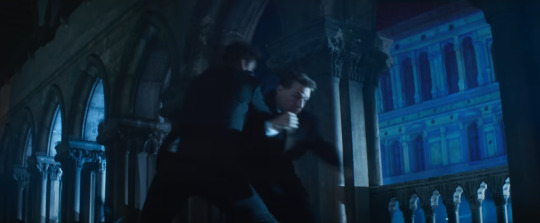
And then immediately to another different angle:

It’s night, and these guys are all wearing suits: not only do all the cuts make it less visually interesting, but it’s hard to keep track of who is where. When we cut to the shot above, I just have to remember that Tom Cruise is the guy who’s doing the throwing (and not getting thrown) based on the continuity of the previous shot, which would not matter if we had simply stayed on that shot!
Back to positive: a thing I will give the Venice sequence credit for is that it was very committed to the idea that when you go to see a Mission Impossible movie, you want to see the characters running. It’s kind of the thing that Tom Cruise is known for.

In the Venice sequence, we up the ante by showing other characters running. (You will have to visit the theater to see this, as it’s not shown in the trailer.) And, it feels kind of silly to say it, but I mean this sincerely: when I saw the other characters running, I thought, “Ah, these guys are definitely proper Mission Impossible characters now. I care about them more than I did before this sequence, and I’m definitely going to remember their faces for the rest of the movie.” It works! You can give anyone Main Character Energy by showing them running and putting in the effort to make it look good!
To end with a criticism: by far the most baffling moment of the Venice sequence comes in a fight with two characters on a bridge, which breaks one of the most fundamental principles of film, which is the 180 degree rule.
For those unacquainted with the language of film, the basic idea is that if a shot is framed with Alice on the left side of the frame, and Bob on the right side of the frame, you should preserve that left-right relationship from shot to shot: you shouldn’t then cut to a shot with Bob on the left side of the frame, and Alice on the right.
You can actually maintain this left-right consistency even when doing shot/reverse shot. For example, take this example from Heat. In this shot, we have Al Pacino on the left of the frame, and Robert De Niro on the right:
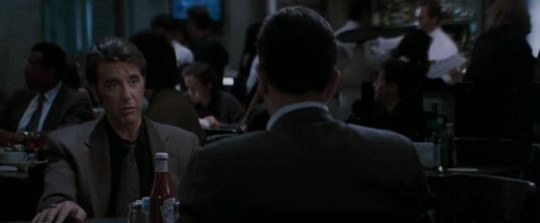
Now we cut to the reverse shot. Notice how, even though we’ve “changed sides” to look at the other actor’s face, Al Pacino is still on the left, and Robert De Niro is still on the right:

What’s most baffling to me is the context in which Mission Impossible 7 breaks this rule: it happens when we’re watching a fight on a bridge, shot in profile. It’s actually a really neat shot. And then, for seemingly no reason, we cut to another profile shot from the other side of the bridge, so that the character who was on the right of the previous shot is now on the left, side of the frame, and character that was on the left is now on the right. This shot doesn’t seem to show us anything we weren’t seeing before -- we’re still looking at two people in profile as they attempt to stab/punch each other, and there isn’t really anything distinctive in the background, especially since it’s a scene at night. And it flips between these angles multiple times. I was just left wondering, why?
It stuck out like such a sore thumb that I was left wondering if it was in fact some bold artistic choice, and I was wrong for being bothered by it. Were it in the context of some other movie franchise, I might lean towards a more charitable interpretation, but this is supposed to be a big summer action blockbuster for a broad audience: I wouldn’t expect a break in form just for...well, I’m really not sure.
And interestingly, basically every complaint I have about the film is isolated to sequence in Venice, which sort of makes me wonder if this is just a product of different “slices of the film being handled by different creative teams” (2 hours and 43 minutes is a lot of runtime to fill), and that’s why certain parts of the movie are just so consistently better than others. In fact, I did notice after the fact that many of the crew listed in the films credits are specifically labeled “Italy Unit.” (I presume that the “Italy Unit” also worked on the Rome sequence, which was great, but maybe daytime driving sequences involve a different creative skillset than nighttime hand-to-hand sequences.)
Anyway, despite the various flaws in the Venice sequence, I can forgive it a lot, because at least it was trying to do something interesting. I’d much rather have a film make me say “what the heck?” than just sit back in my seat, bored with what is going on. It’s got bad moments, but it’s not terrible, and the bad parts exist in relative isolation in a movie filled with lots of good action set pieces. Mission: Impossible -- Dead Reckoning Part One is like a good 6-part TV miniseries with one weak episode.
I also don’t want to neglect to mention just how funny this movie is. Its humor comes not in the form of wise-cracking dialog like I’d associate with e.g. MCU fare; rather, it does a wonderful job of putting characters into comedic situations. For example, there’s a sequence where two characters attempt to flee while handcuffed to each other, and numerous shenanigans ensue. There were many moments that had me (and the other people in the theater) laughing out loud. While there are many funny moments that I’d love to describe, I wouldn’t want to spoil them. Watch the movie!
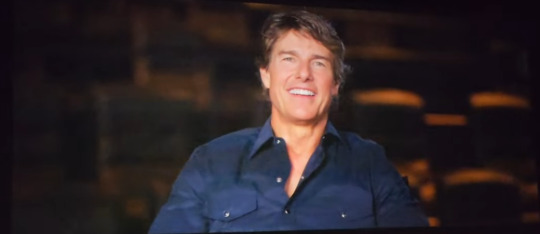
And preferably, you should watch it in a theater, as Tom Cruise told us before the start of the film. This “pre-movie out of character aside” has, without irony, become one of my favorite parts of the theater-going experience: I love it when the actors and/or directors come out to tell me something before (or after) the movie. I loved it when Peter Jackson appeared on the screen to explain why he wanted to make a documentary about World War I, I loved it when John Krasinski welcomed me back to the theater to watch Quiet Place Part II as my first postcovid theatergoing experience, and I loved it when Tom Cruise opened Top Gun: Maverick by thanking the cast and crew and audience who made the magic of movies possible.
I’m fully aware that may just be downstream of the fact that Tom Cruise is an absurdly charismatic person who is good at making me feel a certain way when he talks to the camera. (In fact, I’m pretty sure that’s literally his job description.) But I’m glad that he welcomed me to theater by telling me about how big action movies like Mission Impossible are meant to be seen on the biggest screen possible, surrounded by people who are sharing in the spectacle.
3 notes
·
View notes
Text
Why the movie villain’s henchmen always wear masks
One of those “can’t unsee it” things about modern action movies is the fact that, overwhelmingly, the generic bad guys wear face-concealing masks, particularly in mid-budget direct-to-Netflix action movies. (My definition of “mid budget” here also includes “high budget” Netflix action movies where the bulk of the budget was clearly spent hiring Ryan Reynolds.)

I dislike this for many reasons, but high among them is that it deprives the stunt actors of the opportunity to act with their faces.
For contrast, watch a Jackie Chan movie: a huge part of the fun of Jackie Chan action scenes is the incredibly human reactions that people have when delivering (or taking) punches. When the hero is punching bad guys, it’s not just about the punch itself, but the reaction of the guy who’s getting punched! When someone gets kicked in the face or takes fist to the stomach, I want to see him react with obvious pain!

Even if the stunt actors aren’t amazingly emotive actors, it’s nice when all of the bad guys (even the “generic”) ones are visually distinctive. For one thing, it makes it easier to tell the “generic” characters straight from each other -- it’s simply harder to keep track of the action when the hero is fighting five bad guys who are all basically identical. You can try to get around this by giving the bad guys face-concealing helmets that are visually distinctive, though doesn’t make a ton of sense from a lore perspective, considering the entire point of a uniform is. (Functional uniforms are, by their very nature, and by definition, designed to be uniform. It doesn’t make sense for the Galactic Empire to come up with unique helmets for each individual stormtrooper.)
But apart from the practical issues that come from all of the mooks being indistinct human-shaped blobs, there’s just the fact that as a human, I am deeply biologically hardwired to find human faces compelling. Human faces and bodies can be so delightfully idiosyncratic -- no two people look the same!

And therein lies the problem for the moviemakers. Because if you wish to show dozens of unique human faces, then you need to have dozens of unique human faces.
If all they need to do is be excited faces in a crowd, then you can get extras. But if your movie is about a protagonist delivering bespoke acts of violence to dozens of generic bad guys, then those bad guys have to be played by stunt actors. And if you show us the stunt actors’ faces, audiences will start to notice when you start reusing stunt actors. (Even if we wouldn’t consciously register the fact that Chris Hemsworth is punching the same guy he just killed five minutes ago in a different action scene, our neural circuitry is really good at noticing familiar human faces. As Mike Stoklasa is fond of saying, “You may not have noticed it, but your brain did.”)
So, if you only have half a dozen stunt actors, but the movie calls for dozens of bad guys getting punched or stabbed or shot, then you have to cover their faces.
Realizing this has given me a greater appreciation for movies of this genre that don’t hide the actor’s faces. For example, Nobody is perfectly willing to show us the bad guy’s faces as they get punched, shot, and knocked around, which is great, because it’s a movie that is specifically about the consequences and brutality of violence.

Nobody does have one scene where the bad guys’ faces are covered -- they wear ski masks during the home invasion scene, because it makes narrative sense for them to do so. But ski masks still allow them to act with their faces during the intense moments! You get to see the fear in this guy’s eyes in the moment he realizes what’s about to happen to him.

Nobody’s credits list a whopping 35 names as “stunt performers.” (And that’s not including the actors credited as “stunt double.”)
For comparison, The Adam Project has 9 credited stunt actors. No surprise, then, that all the “generic bad guys” wear helmets. (Not that they get to do much “stunt” work in the moments before they get vaporized into flashing bloodless PG-13 approved CGI dust. Not only does the movie not let you see bad guys’ faces react after they get shot, but it doesn’t even want to let you watch their bodies collapse to the ground.)
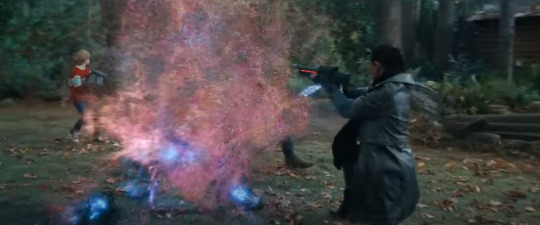
By the way, since it’s the measuring stick that all movies get measured against these days, John Wick credits 59 stunt players. (Again, this is separate and in addition to the tally of “stunt doubles,” which is a different credit.) The John Wick sequels each credit around a hundred stunt performers (John Wick 2 credits 103, John Wick 3 credits 94, John Wick 4 credits 100.)
The decision to cover everyone’s heads with face-concealing helmets can be a stylistic choice -- the Star Wars franchise showcases many of these, including of course the iconic stormtrooper, among many others. However, more and more, it feels like this not a creative design choice, but a practical one.
Movies are a product of human labor and talent, and that costs money. Like a lot of the things involved in making a good movie, hiring a lot of different stunt actors isn’t easy. But I always appreciate the movies that are willing to make the effort, because when audiences see it on screen, they can tell the difference.
86 notes
·
View notes
Text
I’m losing my mind here. And fortunately I have the perfect metaphor to describe this, because it is not the first time this has happened to me:
It is March 2019, and you see people online talking about some new Netflix show, One post says, “I just heard about this show from my older sister. Apparently it’s based on a comic book by some guy who used to be the lead singer some pop-punk she likes.” And then you scroll through find a link to a trailer on YouTube and in the first line of the description see that the “some guy” in question is Gerard Way and deduce that “some pop-punk band my older sister likes” is My Chemical Romance.
Or:
It is February 2021, and you see a post on a video game forum about someone recommending a new episodic visual novel that just popped up on Steam. “This looks like a pretty cool solo project. It’s got an episodic release model, a bit reminiscent of Higurashi or Umineko, but what’s been released so far is pretty solid. It was made by an American developer who apparently got his start as a creator by posting comics he drew to the internet, which is where he first experimented with episodic storytelling. The visual novel itself is sort of a meta-commentary on the cult-like nature of fandom based on what he learned from writing a comic that developed a cult following.” And then you click through to the Steam page and learn that the “comic artist” is Andrew Hussie and the “comic that developed a cult following” is Homestuck.
Or:
It is February 2018, and you get a message from your younger cousin. “Have you seen this meme?” they ask. “It’s based on a clip from an old 90′s cartoon episode. I think my dad used to watch this show.” The “old 90′s cartoon episode” in question is from The Simpsons. (Your cousin cannot get enough of this Principal Skinner character who is trying to pull a fast one on Superintendent Chalmers.)
Have I adequately conveyed that feeling?
This is the exact reaction I had to reading a post in [current year] about “some country music artist my dad likes” and reading a couple paragraphs before finally getting to an embedded YouTube video with the artist’s name in the title to discover that the individual identified only as “some country music artist my dad likes” is Sturgill Simpson.
losing my shit because my dad was telling me that some country music artist he likes went to the hospital and got high off edibles and made an album that was so far removed from being country music that country music fans of his are having fucking fits about it online but that’s not the strange part, the strange part is that this dude sought out the guy who animated those cool 3d jojo intros from parts 1-3 and that one batman ninja movie (i think his name is junpei mizusaki) and got him to animate a full 40 minute short film set to his new weird album and it looks like fucking
youtube
this
#the umbrella academy#gerard way#my chemical romance#psycholonials#andrew hussie#homestuck#the simpsons#steamed hams#music
113K notes
·
View notes
Note
You mentioned that you're writing a web novel - can you share a link to it?
Yep! Re: Dragonize is on Royal Road, here's a link to the first chapter. A slightly edited blurb:
Somewhere in the desert, a dragon egg stirs...
Once a physicist with a promising academic career, Drew wakes up one day to a life in a new world full of deadly creatures, where every day is a fight for survival. Winning fights is a lot easier if you have the power of an apex predator at your disposal...but it'll be a long journey to reach that point. A freshly-hatched dragon can only do so much.
This former academic has always considered violence a last resort. Why turn to fists (or claws) when a more thoughtful and creative solution might be possible? Maybe a life of quiet contemplation is still within reach, but pacifism isn't exactly an option when every carnivore is hungry, and it's eat or be eaten.
6 notes
·
View notes
Text
Names as labels (and what I learned from Brandon Sanderson)
There are a lot of writing lessons I’ve learned from reading Brandon Sanderson.
This is true of Sanderson in a way that isn’t true of a lot of other authors, even those that I like (and strive to emulate), and I suspect this is part of what Sanderson is talking when he describes himself as “more craftsman than artist.” If you ask a craftsman, “How did you get that table to support up to 400 lbs when my table can only support 200 lbs,” there are probably very specific answers that they can give you that you can directly incorporate into your own table-building process. It is significantly harder for a musician to answer a question like “how did you make this song that was so beautiful it made me cry?”
I wish I could write more like Daniel Abraham, but there’s not “one weird trick” that will help you write more like Daniel Abraham. However, if you want to write more like Sanderson, there’s many such specific “tricks” that you, like him, can use to make your writing more effective at communicating information to the reader: Brandon sometimes describes his writing as a sort of “telepathy,” in the sense that he is trying to take a story that exists in his head, and then make that story exist in your head, and a novel is the compression medium that he is using to convey those ideas. Anything that can assist the reader in assembling that story in their head is a plus.
For example, part of the learning curve of any story is learning to attach names on the page to the ideas of characters that we have in our head. A story isn’t just a bunch of ink printed on paper, and a name isn’t just a bunch of letters joined together.
Most of the time, this is trivially easy, especially if the author has done their job properly. Like many rules of writing, it’s something that’s best observed in the breach: if the central characters in your story are Tony, Steve, and Bruce, it’s easier to keep those names separate in our head than names were Jack, Jake, and Joel.
I am unlikely to put “Jason” and “Justin” together in the same story, because as a person named Justin, I know from experience that some people will hear the name “Justin” during an introduction and then later retrieve the name “Jason” from memory when they try to address me. If names are labels for distinct characters that we want to keep separate in our head, it makes sense for those labels to also be distinct enough that the reader won’t mistake one for the other. Octavia shouldn’t be in a story with an Olivia.
If a character is just named “Octavia,” there are some people who, even in the absence of a similarly-named character, will mislabel her as “Olivia” in their head (much in the same way that people have heard me introduce myself as “Justin” and then stored the name “Jason.”) I know this to be true, because I am currently publishing a web novel with a character named Octavia, and there have been multiple comments from people referring to her as “Olivia.” And this is fine, because when I read their comment talking about “Olivia,” I know they are actually talking about Octavia, because in my story, the label “Olivia” is unoccupied real estate (and Octavia is free to occupy it if she wishes).
This obviously isn’t true of the real world: if someone calls me Jason, I can’t decide, “Well, it’s okay for you to call me Jason, and in fact in order to remove any ambiguity that you might be addressing me when you say that name, I will go and erase every Jason from existence. Also, I’m erasing all the other people named Justin.” (That’s not only impossible, but even if it was possible, it would be unreasonable for you to expect that I do it, just to make things slightly more convenient for you.) But in the context of a story that I’m writing, I can totally do this. I can go to these “unreasonable” lengths to make things ever so slightly easier for the reader. In fact, it’s trivially easy to pick a distinct moniker for each cast member. Names are abundant, even if I have self-imposed restraints like “don’t let two characters’ names start with the same letter and vowel sound (e.g. Roger and Robert, Crystal and Christine), and "don’t have two names of similar/equal length that end in the same letter and/or phonetic sound” (e.g. Sarah and Clara, Mindy and Tracy, Travis and Jarvis, Jerry and Gary).
Of course, there’s a corollary to this, which is that insofar as it makes sense to give characters distinctive monikers to keep them as distinct concepts, it also makes sense to give them similar monikers if you want them to be less distinct from each other. (For example, Jack and Jill are joined at the hip. Ditto for Re:Zero’s Rin and Ram.) Even so, I still think this tends to work best when the names are joined by something that’s non-phonetic: for example, Katniss and Primrose are names that evoke flora. April and May are right next to each other on the calendar.
And what if you have two names for the same character? It’s a point that seems obvious, but I didn’t realize it until Brandon Sanderson gave me a glaring example:
In Mistborn, when Vin goes undercover to infiltrate noble society, her alias is Valette. This is absurdly easy to keep straight, because these are the only two names in the book that start with V. (And there’s no confusion about which name she uses among her fellow street toughs and which name she uses when she’s pretending to be an aristocrat: Vin is terse, Valette is sophisticated.)
And, in a sense, your “past selves” are distinct from your present self in many ways, except for the ways that they’re not. (Or as Orwell put it, “what have you in common with the child of five whose photograph your mother keeps on the mantelpiece? Nothing, except that you happen to be the same person.”)
Kaladin, the main viewpoint character in the first book of the Stormlight Archive, went by Kal when he was a kid. This comes in real handy, because the story is partially told through flashback. When you have a book that’s 400,000 words long, you’re going to have to put it down at some point and come back to it later, and it’s really helpful if, when you pick up the book after a week-long break, there’s some indicator that makes it completely and unambiguously clear that you’re in a flashback. And indeed, the book offers exactly that: in the childhood flashbacks, you will see the viewpoint character referred to in narration as “Kal” multiple times on every page.
156 notes
·
View notes
Text
What makes movie action “good?”
There’s a John Wick movie in theaters. There seems to be pretty uniform agreement that John Wick movies have great action, and simultaneously, there seems to be a lot of general “Marvel fatigue,” some of which is specifically about the MCU, but also some of which is about “action blockbusters” that seem to put a lot of focus on action and spectacle that a lot of people seem to be growing increasingly disenchanted with. (See, for example: Tomorrow War (2021) starring Chris Pratt, Extraction (2020) starring Chris Hemsworth, and to round out the Chris roster we also have Wonder Woman 1984 (2020) with Chris Pine.)
Most of the discussion tends to focus on effects, and how making everything in a computer feels soulless while practical effects like the ones in John Wick and Everything Everywhere All At Once are superior, and there’s a certain degree to which blockbuster CG does look worse due to everything being computer generated. But I think a much bigger and more deep-seated problem is that blockbuster action is poorly structured.
There are a lot of great practical scenes in John Wick with choreography that is great not just in execution, but in concept: if you recreated them with computer animation, or hand-drawn animation, many of them would be just as fun. You could look at a storyboard with a director’s poorly-drawn pencil sketches and you’d still be able to follow the logic and understand what the scene’s impact is supposed to be. You can tell this, because people can describe these scenes, and regularly do exactly that, because they’re memorable. It’s what the legend of John Wick is all about. (And it’s not just the “top 10 most creative John Wick kills” listicles that remind us of that fact.)

The thing is, John Wick doesn’t rely on the unique outlandish props for memorable kills. Most of John Wick’s kills boil down to “point gun, pull trigger.” And yet despite that most of his kills are with bullets, so many of them feel unique. Each scene feels like it has a tempo to it, a sense of flow, a chain of cause and effect. “That guy is hiding behind a pillar, but his toe is sticking out. So I’ll shoot him in the toe, causing him to bend over in pain, exposing the rest of his body so I can shoot center of mass.” There’s always the moment when John Wick runs empty and has to reload before delivering the killshot.
There’s a storytelling principle that’s often applied to plot structure. This was famously described by Trey Parker to a bunch of NYU students on MTVU's "Stand In." Trey Parker describes the writers room as containing a massive white board, split into 3 acts, where they write down ideas scenes and rearrange them. Each scene has to be entertaining by itself, but they also need to be connected by a coherent narrative through-line.
"You don't want just one scene where, 'well, what was the point of that?' Take the beats of your outline, and if the words 'and then' belong between those beats, you've got something pretty boring. What should happen between every beat that you've written down is either the word 'therefore,' or 'but.'”
A happens, therefore B happens. Or, B doesn't happen, but C happens, therefore D happens. Repeat. You can use this to structure the plot for a 25-minute TV episode, or a 120-minute movie, or a 2-minute action scene. Follow it, beat by beat, and see if one leads to the next:
One of the evil henchmen comes swinging at our hero with a wooden chair raised over his head, but the hero dodges and the wooden chair smashes against the floor, shattering. Therefore, the ground is now covered with the broken remains of a wooden chair, so the mook picks up one of the long pieces of wood that served as a chair leg and begins swinging at the hero again. But the hero successfully dodges and the wooden club breaks and splinters in a way that causes it to become, therefore the mook starts trying to use the splintered end to stab the hero...
I’m not saying this is an amazing action scene, but it’s a competent one: each beat flows into the next. The chair becomes a chair leg, then the chair leg becomes a shiv. Each time the henchman comes rushing at the hero, he’s doing it with a different weapon. The scene has a logic to it: if you rearranged the shots, the scene wouldn’t make sense. You can’t start with a splintered piece of wood and then end on an intact chair.
So many mediocre action movies fail to deliver it. The bad guy punches the hero. And then he punches the hero again. And then he tries to kick the hero. And then he punches in a different, cooler way. There’s no real sense in which each beat is a consequence of what followed it: if you cut the scene up and rearranged the shots, a lot of people might not even notice. (And in fact that sort of thing happens all the time in the editing bay.)
Tony Zhou self-deprecatingly describes this problem when critiquing one of his own videos, saying “This is a list you could put in any order. That’s why it’s so boring.”
For examples of action cinema where every beat feels like a consequence of what preceded it, watch any classic Jackie Chan movie (the ones that came out of Hong Kong, not Hollywood). Tony Zhou describes it like this:
“So how does Jackie create action that is also funny? First off, he gives himself a disadvantage. No matter what film, Jackie always starts beneath his opponents. He has no shoes. He’s handcuffed. He has a bomb in his mouth.“

“From this point, he has to fight his way back to the top. Each action creates a logical reaction. And by following the logic, we get a joke.” (Jackie is facing an assailant with a gun; Jackie has a gun, but it’s empty. Therefore, Jackie fakes surrender, handing his empty gun to the assailant. Therefore, the assailant is now holding an unloaded gun in his left hand. The assailant now thinks he has control of the situation, but reaching for the unloaded gun distracted him the fact that Jackie was entering a fighting stance and getting ready to kick: therefore, when Jackie kicks, he succeeds in knocking the loaded gun out of the assailant’s right hand. Therefore, the assailant tries to fire at Jackie using the gun in his left hand -- which is empty, and he realizes it in a moment of surprise which Jackie seizes on by punching the assailant in the face.)
This is the joy of watching Jackie Chan films: much like the example of a chair (which morphs into a chair leg, which morphs into a shiv), a prop in a Jackie Chan movie is rarely just one thing. A ladder isn’t just a ladder; it’s a prop. And it’s several different kinds of props. Fighting with a ladder like this:

...is subtly different than fighting with a ladder after this happens:
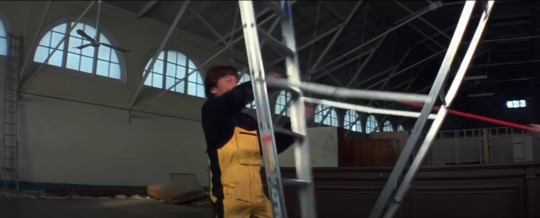
And if you flip it over a guy’s head, it suddenly becomes a cage:

...trapping a guy just long enough for him to look at you in surprise right before your fist intersects with his face.
It’s great for action comedy, but it’s also great for straight action: sometimes, the “punchline” is someone getting defeated in a surprising way. John Wick is one of the few big franchises of recent years to reliably do this sort of thing well.
Often, John Wick accomplishes this by being clever. But I think a big part of it comes down to the fact that John Wick is just mortal enough for the number of bad guy’s he’s facing to matter. Each scene needs a sense of “progress,” where the stakes are constantly changing, and sometimes the change in stakes is as simple as, “There are five bad guys, oh no!” Bang bang, pivot, bang bang. “Okay, now there are only three bad guys.” (It’s harder to do this when you’ve been injected with super soldier serum and wear a suit made of high-tech blast resistant stretch fabric: Captain America subduing five bad guys doesn’t feel meaningfully different from him subduing three bad guys, even if the way he punches them is really cool.)
Stakes matter! If threat level scales linearly with the number of bad guys on screen, then each scene will have a natural eb and flow to it as bad guys get gradually picked off (or as more of them stream into the room, or pick themselves up off the floor and reach for the gun they just dropped).
One of the MCU scenes that actually did this better than most is the famous Captain America elevator scene: first, Crossbones and two guys get onto the elevator with cap. A bit surprising. Why is that guy resting his hand on his hip so close to his gun? Several floors later, the elevator opens, and four more guys get on. They’re wearing suits, like you’d expect from people who just showed up for a day at the office. This is headquarters, there’s nothing to be worried about. So why is that guy sweating? Then, the door opens again, and three more guys get on -- and these guys are wearing tac gear. But hey, it’s Jack -- I know Jack, he was in the first ensemble movie, he can’t be one of the bad guys...so why is he standing directly between me and the door?
It’s a great example of slowly amping up the tension by gradually adjusting the threat level up. The scene even amps up the tension by having the magnetic handcuff, which leaves Cap in various stages of incapacitation throughout the fight. And he has to fight his way up from the bottom. But we very quickly go from this iconic shot:
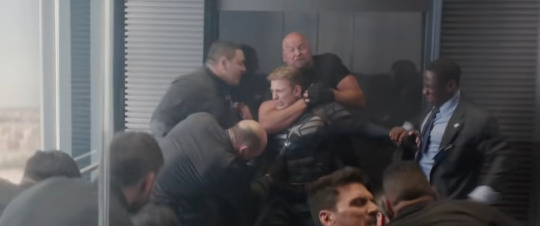
...then after literally three seconds of Cap delivering a rapid series of strikes to incapacitate most of the mooks, he’s back to fighting two or three of them at a time.
Despite there being ten bad guys in the elevator, it’s kind of hard to get a clear fix on how many of them attacking Cap at any given moment, all of the others existing in various states of injury and recovery after they get the wind knocked out of them. In fact, the only shot that allows us to get a full body count is after the fight is over:

But it’s still a fun scene, one of my favorites, succeeding at being fun and memorable.
The bigger issue is the need to be “epic”: threat level can’t scale linearly with the number of bad guys on screen when you want a scene where there are literally hundreds of enemies to fight off.
There’s a certain point at which the marginal effect of another bad guy on screen is effectively zero. Obviously, this is the case when you have hundreds or dozens of enemies on screen, but there’s a real sense in which “group of seven bad guys” doesn’t feel different from “group of six bad guys.” Our brains just categorize both as “a pretty big cluster.” Research tends to come to slightly different results on this, but it seems like humans count “one, two, three, four, many.” Once you have five bad guys on screen, adding a sixth bad guy doesn’t do anything to change the stakes. (That’s the problem with having a hero who’s so strong that you need to throw 10 bad guys at him to pose any threat.)
If you cap the total number of on-screen bad guys at five, then each enemy the hero defeats meaningfully changes the stakes, and John Wick does this a lot. In many cases, the flow just comes from watching the number of bad guys on screen decrease linearly as the hero picks them off, one by one. It gives the scene a natural scenes of progress, and it can sometimes be played for comedy, like Neal Stephenson does in Snow Crash in a scene described by a sniper’s dialog:
"It's, like, one of them drug dealer boats," Vic says, looking through his magic sight. "Five guys on it. Headed our way." He fires another round. "Correction. Four guys on it." Boom. "Correction, they're not headed our way anymore." Boom. A fireball erupts from the ocean two hundred feet away. "Correction. No boat."
That’s a (very short) scene with flow. You can’t rearrange the beats; every beat leads to the next. Follow the logic, and arrive at the punchline.
244 notes
·
View notes
Text
The document cites some interesting precedent: apparently US copyright law has previously covered the question of whether religious prophets recording their revelations and transcribing “divine messages” can claim copyright over the words that were (allegedly) authored by another spiritual entity:
The Ninth Circuit has held that a book containing words “authored by non-human spiritual beings” can only qualify for copyright protection if there is “human selection and arrangement of the revelations.”
Urantia Found. v. Kristen Maaherra (9th Cir. 1997): “some element of human creativity must have occurred in order for the Book to be copyrightable” because “it is not creations of divine beings that the copyright laws were intended to protect”. While the compilation of the book was entitled to copyright, the alleged “divine messages” were not.
The definition of “non-human spiritual being” leaves some room for interpretation: what about psychics communing with literal ghost writers? Is the spirit of a deceased person a “non-human spiritual being,” or do they still count as human when visiting from beyond the grave?
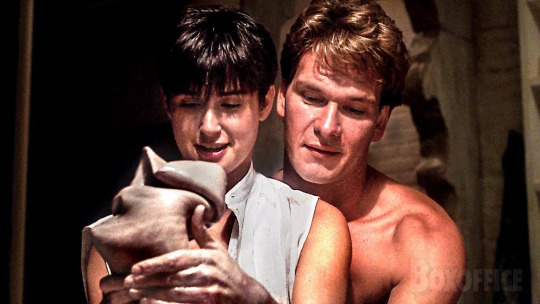
Perhaps it’s considered on a case-by-case basis: if you’re a sexy Patrick Swayze-style ghost, then you’re a “human spiritual being” and can claim to have partial copyright ownership over any pottery that you collaboratively create with Demi Moore. But if you’re an ectoplasm entity who manifests as a goofy cartoon that the Ghostbusters have been called in to exterminate, you’re clearly non-human (both in appearance and origin) and thus don’t own copyright.
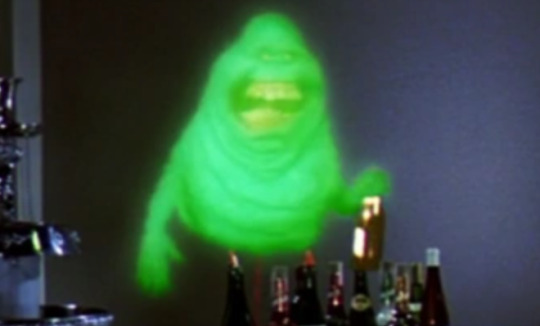
However, some cases are more ambiguous: What if the ghost isn’t a manifestation of a person’s entire soul, but just an aspect of it (e.g. “a human’s desire for vengeance given physical form”)? Does Chucky count as a “non-human spiritual entity” due to being a talking doll, or would any creative work by Chucky be considered to be the intellectual property of the deceased killer who possessed the doll? And what about copyright terms ending “70 years after the death of the author” -- does that mean that if a person died before 1953, anything they “ghost write” in the present year instantly enters the public domain? It seems there’s much for movie scriptwriters (and copyright law) to consider here.
The US Copyright registry just came out saying AI art is not copyrightable. Giving a prompt is not enough to make it count as "human created".
A court could rule differently in a court case someday, but this a good development for the fans of the public domain.
Also suggests a future potentially where teams of artists are employed to give just enough input to finished products that they are copyrightable.
163 notes
·
View notes
Text
RRR is about a culture fighting for its right to exist
Since RRR hit Netflix and reached a global audience, I’ve heard many recommendations for the film, all of which take the form of something like, “This movie is crazy! There’s a scene where they attack a palace by unleashing a horde of wild animals, you have to see this movie!” Or “they introduce one of the main characters by showing him wrestling a tiger!”
These sorts of comments did basically nothing to persuade me to check it out. But I finally did check it out, entirely thanks to the recommendation of Jason Pargin, who (on “We Just Watched” with Dave Bell) provided a great explanation of how the movie actually uses spectacle to convey theme, mostly by vocalizing the subtext in one pivotal scene. (What follows is taken from their exchange, lightly paraphrased/edited for readability)
Jason: There's different kinds of spectacle. For example, the thing that RRR is up for an Academy award, is a song that is from a dance number, 60 minutes in, where most American movies have the key pivotal twist or action scene. In RRR, it's a dance-off. If you had that in an American movie, it would be parody: "isn't it wacky that we're gonna stop and dance 60 minutes into the movie? But in RRR, the song that is nominated for an academy award, the version that's up is the original Telugu version, Naatu Naatu, it just means 'dance dance.' It is a scene where the two superhuman heroes, both men undercover, they think they're friends, they're secretly working to do something else; Bheem's trying to get this kidnapped child back, and at this time you think Ram is hunting Bheem.
They go to this big party at the headquarters where the British are, because they have befriended a woman who's part of the British governor’s family, that's their in. They realize where the child is being held. The key is, they're infiltrating, right? So they both have to put on western style suits and attend among all these British people, and they're being treated like crap.

Bheem starts getting bullied by this British guy. We know, from watching the movie to this point, that Bheem could kill this man with three of his fingers. Bheem would not break a sweat breaking this guy's entire body in half. But he can't do that; he's undercover. And his best friend Ram is also undercover; they can't turn this into a fight, and they know it.
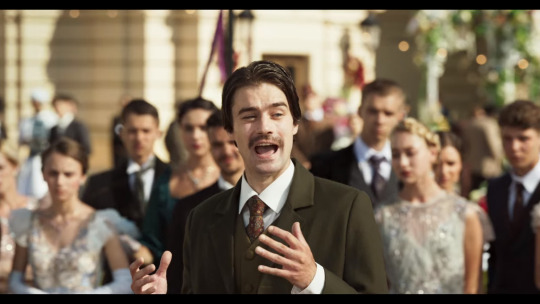
Jason: So the evil British guy gives a speech, because they're all dancing, it's a fancy dance for fancy people. He has had a cultured upbringing in the best British schools, and knows all these different dance styles, and starts talking as if, "Why do we care that we're erasing this culture? They don't have a culture. These people just live in mud floor huts, what do they have? What difference does it make if this culture vanishes, if there's nothing to it? They’re savages."
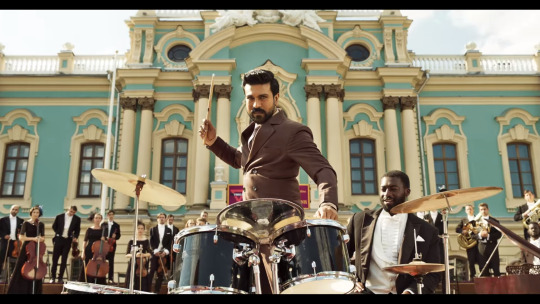
And then Ram starts playing the drums, and walks up and says, "Yeah, I dunno about any of those dances, have you ever heard Naatu, this dance we do?" And then this dance sequence explodes, as spectacle.

It starts as an extremely jaunty tune, the lyrics are like, "come, do this dance!" and it's inviting them. And then the song goes faster and faster and faster, and the dancing becomes more and more frantic, because they are in this dance trying to outlast these British guys who are trying to keep up with them. It's a dance-off, but they are dancing for the right of their culture to keep existing. They are dancing because they're trying to say, "We will outlast you. We can dance longer than you. This is the spirit that you're trying to break. Let us show it to you in the form of dance." It is spectacular. The definition of spectacle.
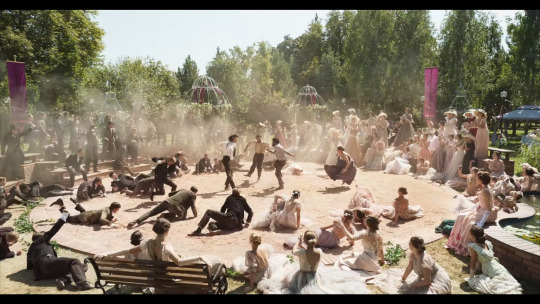
Dave: It's a violent dance, but just to make sure it's clear, it's a joyful dance. It's fun, it's violently fast and complex, and you look at it like "Geez, that would kill me to try, but the whole time they are smiling. They are having a blast. They get everyone into it at the party. There are people who are genuinely won over by it. Obviously the one British guy isn’t, but it also the idea of, “Not only do we have this, but you f-ing love it.”

Jason: Yes, that’s the key. All these bystanders start cheering for them because, "oh, they're right!" And Bheem and Ram are smiling and happy the entire time, because they have to be. You actually see Ram, part of his dance is trying to show the evil British guy -- again, a man who is in the process of genociding his people -- trying to show him the dance, and smiling at him, giving the thumbs up, like "yeah, now you're doing it, now you're doing it!" because he has to. He can't be aggressive there; he has to blend in, like "oh yeah, we're all buddies here, we're all just friends."

Jason: There's all this subtext, and there's a reason that song got nominated and won the Golden Globe, got nominated for an Academy award, I would bet it will win. ... It is a perfect example of what spectacle can be, in that it is joyful. It is not showing off technical [effects]; it is showing off a bunch of people who had to train for weeks and choreograph for weeks and have been dancers all their lives because you can't be an Indian cinema superstar without being a great dancer and singer and everything else.
7 notes
·
View notes
Text
The King’s Dilemma is a game about roleplaying
I just played my first game of The King’s Dilemma, which is the most fun I’ve had playing a board game in a long time (and that’s speaking as someone who plays a lot of board games and has a collection that is entirely too big).

This man is suffering, but not from success.
The entire game is about reading cards from a deck that present you (the leaders of the noble houses of the kingdom, who are the the real leaders standing behind the figurehead king) with questions and voting on them (with various consequences, negative or positive). The things you do affect the kingdom’s military strength, economy, health, morale, and knowledge.
A merchant sold spoiled food to your citizens. Do you punish the man and make an example of him? If you do, it will discourage anyone who might try to do the same (improving the health of your kingdom), but it might also have a chilling effect on trade (worsening the economy). Punishment or no? Aye or nay?
You’ve discovered a rare metal that might be useful for forging weapons. Will you use it to bolster your own military, or seek economic benefits through trade?

Each card has printed icons showing some of the immediate consequences...but once you flip the card over and read the prose describing the aftermath of your decision, you’ll often discover that there may be hidden consequences that might have only been vaguely hinted at by the front half of the dilemma card. (This is the part where the game tells you to “open envelope #46, read the story card, then add the rest of the cards from the envelope to the dilemma deck.” The deck is shuffled each time, but the further you progress, the more likely you are to confront the consequences of past votes.)
Every member of the council can commit any number of power tokens from their supply to either an “Aye” or “nay” vote...or take the third option, and abstain. (Because you stayed home to attend to your house’s affairs instead of attending the vote, choosing to abstain from the vote allows you to accrue a bit of power which you can use for future votes, as well as money, which can’t vote directly, but might be used to bribe other players in future votes.) In addition to the direct consequences of your actions, new story cards will be added to the deck, presenting you with branching consequences for whichever path the council decided would be best.
However, what’s good for the kingdom may or may not be what is best for your particular noble house. The game begins with everyone secretly drafting a card which defines their own scoring conditions.

Sometimes your secret agenda will oppose someone else’s objectives: for example, the opportunist (who wants the kingdom to be weak) is directly at odds with the person who desires opulence (and wants the kingdom to be strong along every metric). However, more often than not, your goals are orthogonal to other players: the moderate player wants all of the tracks to be close to the middle, which means that they’ll want to strengthen military efforts if the nation’s borders are looking weak, but they’ll start to do the opposite if the nation’s military starts getting too strong.
This orthogonality of hidden victory conditions around the table leads to natural shifting of alliances throughout the game in a way that’s completely organic, which also leads to great moments of drama and betrayal when the person who you cooperated with on the last 3 votes agrees to help you with another vote, only to reverse course at the last minute. (Of course, you knew that eventually, your interests would diverge, something that you will surely bear in mind as you curse your former friend’s sudden yet inevitable betrayal.)
This set of hidden incentives is what undergirds every vote in the game: everyone’s route to victory looks different, and it may or may not coincide with a prosperous kingdom.
The King’s Dilemma is a game that encourages light roleplaying. Every reviewer who talks about the game says this, and it’s true: a big part of the fun comes from the fact that you’re pretending to be the leader of one of twelve different noble houses, and a lot of the fun happens from picking a house with a philosophy that you get to embody, with each house having a tagline like “Never Break a Deal” (the motto of the merchant house) or “Tranquility In Death” (the house that takes on the unenviable task of defending the southern border, and seems to enjoy war and conflict just a bit too much). It’s exactly the kind of thing that appeals to the sorts of YouTube shows that are “friends sitting around a table, dressed in medieval costumes and playing larger than life characters.”

Funhaus, true to their channel name, clearly had fun with this one.
But the game is also about roleplaying in a different way: there’s a real sense that, within the fiction of the universe that the game inhabits, every single debate that takes place is kind of a LARP.
For example, on the final dilemma of the night, we were presented with the question of whether we should raise taxes on the prosperous and flourishing metalworkers guild for the purpose of feeding the poor. As the first person to vote, I began with an impassioned speech about how as the nobles who had been tasked with stewardship of the kingdom, it was our responsibility to ensure that all people in the kingdom benefitted from the kingdom’s prosperity, and that passing the tariff would be the best way to ensure this.
However, my true reasons for trying to persuade the table of an “aye” vote were far more cynical: it’s true that I wanted the “community welfare” track to stay high, but this was largely because I had a objective token that meant that my house would be blamed (and thus lose prestige) if the kingdom’s welfare got too low. If we didn’t come up with an immediate short-term solution to the current hunger crisis, my house would lose 3 prestige points! And so my character, within the fiction of this world, LARPed as someone who was concerned with the welfare of the people, when in fact he was only concerned with the image of his noble house. How do I know that my character was only cynically LARPing as someone who cared about charity? Because as soon as someone at the table offered me 12 gold to change my vote, I immediately accepted the offer.
It was one of those perfect moments of ludonarrative harmony, where the game’s mechanics perfectly convey the game’s themes and story. What better way to tell a story about cynical, self-interested, backstabbing aristocrats who treat politics as nothing more than an exercise in gamesmanship than by presenting us with a set of game mechanics that would guide us to act out those exact scenarios ourselves?
The game was full of moments like this, where the theme just sang. And what’s best is that these moments will happen, even if you don’t go out of your way to “lean into the fun.” This isn’t a game where you have to choose between doing the “fun” thing instead of doing the thing that will make you win: the game’s mechanics are structured such that the best moments emerge as a result of everyone at the table ruthlessly pursuing whatever tack will result in them having the largest share of victory points at the end of the game.
Every moment is about doing the thing that will benefit you most, all the while trying to persuade everyone at the table that what you’re doing will actually be beneficial for them, and they should totally support you in the resolution that you’re trying to pass (or block)...while also hinting that, while you are definitely defending your position out of principle, you’re not so principled that you couldn’t be persuaded to change positions if they made the right offer.
The game continues until the king abdicates or -- if the council governs well -- until enough years have passed that the king dies of old age. Our king lived long enough to die in his bed, surrounded by his loved ones (and us, his council of scheming advisors). And as I proved more successful in scheming and earning prestige than anyone else at the table, I get to name the king’s heir, who will take the throne for next week’s game. I won tonight’s game, but the campaign has just begun. The king is dead, long live the king.
12 notes
·
View notes
Text
I was looking at the FAQ for a website that sells flavored electrolyte drink mix packets, and one of the things that really stood out is that on the FAQ page, the very first section they have is titled “homebrew,” asking “want to make your own version of our product at home with the same ratios we use? Here’s an ingredients list.” (Is that really one of the “Frequently Asked Questions” they receive?) The recipe even helpfully notes things like “500 mg potassium citrate powder will provide ~200 mg potassium.”
I kinda love this, and it feels like the ultimate flex, because the very first thing that the company is telling you on their FAQ page is, “You don’t need to buy our product. You can get 100% of the nutritional benefit from these common ingredients which you can purchase much cheaper in bulk.”
It’s anti-ad copy. It’s kind of refreshing to see this, when there are all too many websites out there trying to sell you on the idea that the supplement they’re selling is somehow unique, and that they’re offering some kind of secret sauce that you won’t be able to find anywhere else.
And, in the end, it doesn’t really undermine the core value proposition, because on a certain level, I know that I could mix my own electrolyte cocktail with common ingredients that I can buy in bulk, but the reason that I’m on their website is that I’m interested in the convenience of having a bunch of identical pre-measured packets instead of having to measure out everything myself (plus getting a “variety pack” with 10 different flavors, which isn’t something that you can easily do at home), and ultimately that convenience will be worth the fact that I’m paying ~$1 per packet, because even though I’m “only getting 20 cents worth of ingredients,” the convenience is worth more than $1 to me.

Also, what the heck, since I like their “anti-ad copy” approach enough to write about it, I’ll mention the brand in question, it’s LMNT. They didn’t pay me to talk about them, but they did pay Adam Ragusea to talk about them on his cooking podcast, which is how I found out about it. (Yes, podcast advertisements do work!) I’ve consumed enough of the product to know that it’s exactly what it purports to be, which is “flavored drink mix packets with provide a certain electrolyte mix,” with the premise being that it’s a healthier alternative to drinks like Gatorade and Powerade (which both have about as much sugar as soda).
7 notes
·
View notes
Text
My entire life I’ve been hearing people refer to Gerard Butler and every time I’ve thought “oh that’s interesting, I don’t remember the My Chemical Romance guy being in that movie, but it’s cool that he has an acting career.”
7 notes
·
View notes